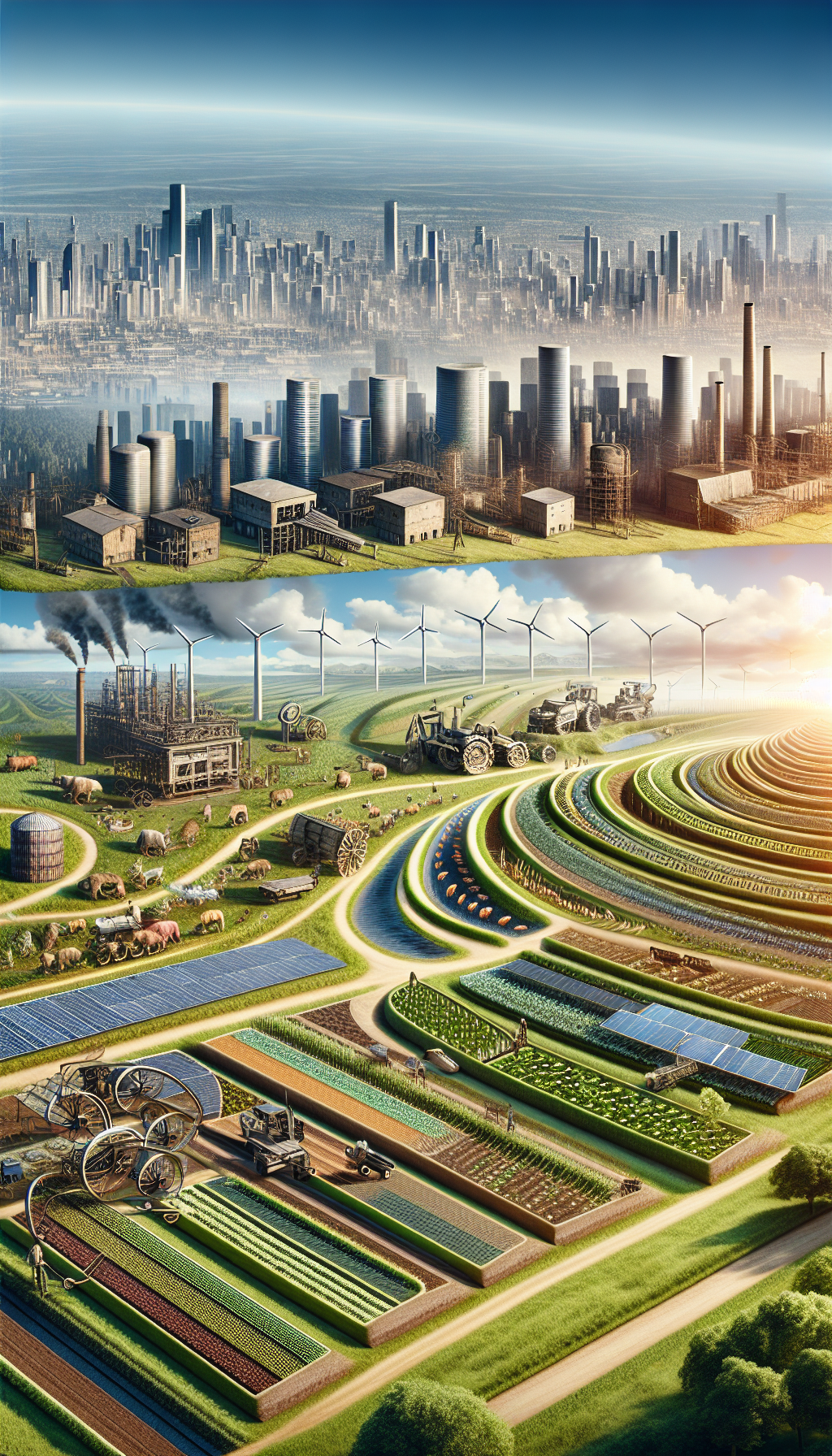Early Concepts of Sustainability
The concept of sustainability, while seemingly modern, has roots that stretch back centuries. Early human civilizations displayed an inherent understanding of sustainability in their agricultural practices and resource management. For instance, indigenous cultures around the world practiced rotational farming and polyculture, techniques that naturally replenished the soil and promoted biodiversity. These practices were not only crucial for the survival of these communities but also laid the groundwork for sustainable agricultural methods used today.
In the ancient world, several societies demonstrated early principles of sustainable living. The ancient Egyptians, for example, developed an intricate system of irrigation from the Nile River, ensuring that their agricultural lands remained fertile and productive. Similarly, in Asia, the concept of sustainability can be traced back to the teachings of Confucius and Taoism, which emphasized harmony with nature and the responsible use of resources.
As societies evolved, so did their approaches to sustainability. The Middle Ages saw the implementation of crop rotation and the three-field system in Europe, which improved soil fertility and increased food production. These methods highlight the growing awareness of the need to balance human consumption with environmental preservation. Below is a table illustrating some early examples of sustainable practices:
| Culture | Practice | Impact |
|---|---|---|
| Indigenous Tribes | Rotational Farming | Soil Replenishment |
| Ancient Egyptians | Irrigation Systems | Fertile Land |
| European Middle Ages | Crop Rotation | Increased Yield |
Despite these early advancements, the industrial revolution marked a turning point that posed new challenges to sustainability. The shift towards industrialization brought about increased exploitation of natural resources, leading to significant environmental changes. This period highlighted the need for a more structured approach to sustainability, which would later influence contemporary environmental movements.
The Industrial Revolution’s Impact
The Industrial Revolution, spanning from the late 18th century to the early 19th century, marked a significant turning point in human history, profoundly influencing the concept of sustainability. This period was characterized by a rapid shift from agrarian economies to industrialized ones, driven by advancements in technology and manufacturing processes. As industries flourished, so did the exploitation of natural resources, which led to unprecedented levels of environmental degradation. The mass consumption of coal and the rise of factories resulted in severe air and water pollution, highlighting the need for sustainable practices.
During the Industrial Revolution, the concept of sustainability was not yet defined as we know it today. However, the environmental consequences of industrial activities laid the groundwork for the future development of sustainable practices. The negative impacts, such as deforestation and the depletion of natural resources, prompted early thinkers to consider the balance between economic progress and environmental stewardship. The notion that resources were finite began to take hold, leading to the early roots of sustainability.
The era also witnessed the birth of significant social and economic changes, including urbanization and the rise of a consumer-based society. These changes were accompanied by an increased awareness of the social implications of industrial growth. As a result, the Industrial Revolution played a dual role by highlighting both the potential for human progress and the risks associated with unchecked exploitation of natural resources. This period set the stage for the emergence of environmental movements and policies aimed at promoting sustainable development.
To better understand the impact of the Industrial Revolution on sustainability, consider the following data:
| Industrial Factor | Impact on Environment |
|---|---|
| Coal Consumption | Increased air pollution and greenhouse gas emissions |
| Deforestation | Loss of biodiversity and disruption of ecosystems |
| Urbanization | Increased waste production and water pollution |
In conclusion, the Industrial Revolution was a catalyst for the development of sustainability concepts. It revealed the critical need for a balance between industrial growth and environmental preservation, shaping the trajectory of sustainability discourse for future generations.
The Birth of Modern Environmentalism
The birth of modern environmentalism can be traced back to the mid-20th century, a period marked by heightened awareness of the impact of human activities on the environment. This era saw the emergence of several key events and figures that played pivotal roles in shaping the modern environmental movement. The publication of Rachel Carson’s seminal book, Silent Spring, in 1962 is often credited with igniting widespread public concern about the use of pesticides and their detrimental effects on the environment and human health. Carson’s work challenged the practices of agricultural scientists and the government, leading to a nationwide ban on DDT and other pesticides and inspiring a grassroots environmental movement.
During the 1960s and 1970s, environmentalism gained momentum as a social and political movement, resulting in significant legislative and institutional changes. The first Earth Day, celebrated on April 22, 1970, mobilized millions of people across the United States to advocate for environmental protection, leading to the establishment of the Environmental Protection Agency (EPA) later that year. This period also saw the passage of groundbreaking environmental laws, including the Clean Air Act, the Clean Water Act, and the Endangered Species Act, which collectively laid the foundation for modern environmental policy in the United States.
- Rachel Carson’s Silent Spring (1962): Highlighted the dangers of pesticide use.
- First Earth Day (1970): A pivotal event that galvanized public support for environmental issues.
- Establishment of the EPA (1970): A major step in federal environmental protection efforts.
Furthermore, the international community began to recognize the importance of environmental protection, leading to the United Nations Conference on the Human Environment in Stockholm in 1972. This conference established the United Nations Environment Programme (UNEP) and marked the beginning of a series of global efforts to address environmental issues. A significant outcome of the conference was the consensus on the need for sustainable development, which would later become a central theme in global environmental discourse.
| Year | Event | Significance |
|---|---|---|
| 1962 | Publication of Silent Spring | Raised awareness about the environmental impact of pesticides. |
| 1970 | First Earth Day | Mobilized public support for environmental protection. |
| 1972 | UN Conference on the Human Environment | Led to the establishment of UNEP and emphasized sustainable development. |
Sustainability in the 20th Century
The 20th century marked a significant turning point for sustainability, as industrialization and technological advancements began to exert unprecedented pressure on the environment. During this period, the concept of sustainability started to take shape, influenced by the growing awareness of environmental degradation and resource depletion. Rachel Carson’s seminal work, Silent Spring, published in 1962, is often cited as a catalyst for the modern environmental movement. Her book highlighted the adverse effects of pesticides on the environment, sparking public concern and leading to policy changes.
Throughout the century, several key milestones emphasized the importance of sustainable practices. The 1972 United Nations Conference on the Human Environment in Stockholm was a pivotal event that brought global attention to environmental issues. It laid the groundwork for future international environmental agreements and introduced the concept of sustainable development. In 1987, the Brundtland Report, formally known as Our Common Future, further popularized the term “sustainable development,” defining it as development that meets the needs of the present without compromising the ability of future generations to meet their own needs.
The latter part of the 20th century saw the implementation of various agreements and protocols aimed at promoting sustainability. Notable among these was the 1992 Earth Summit in Rio de Janeiro, which resulted in the adoption of Agenda 21, a comprehensive plan for sustainable development worldwide. The summit also led to the formation of the United Nations Framework Convention on Climate Change (UNFCCC) and the Convention on Biological Diversity. These initiatives underscored the global commitment to addressing climate change and preserving biodiversity for future generations.
The emergence of non-governmental organizations (NGOs) focused on environmental issues also played a crucial role in promoting sustainability during this period. These organizations, along with grassroots movements, heightened public awareness and advocated for policy changes at local, national, and international levels. As a result, sustainability became increasingly integrated into governmental policies, corporate strategies, and individual lifestyles, setting the stage for the environmental challenges and solutions of the 21st century.
The Role of the United Nations
The United Nations (UN) has played a pivotal role in the global movement towards sustainability, acting as a catalyst for international cooperation and policy-making. The organization’s commitment to sustainability can be traced back to the mid-20th century when environmental concerns began to take center stage in global discussions. In 1972, the UN hosted the Stockholm Conference on the Human Environment, marking the first major international gathering focused on environmental issues. This conference laid the groundwork for subsequent UN initiatives aimed at promoting sustainable development worldwide.
One of the most significant contributions of the UN to sustainability was the establishment of the Brundtland Commission in 1983. Formally known as the World Commission on Environment and Development, it introduced the concept of “sustainable development” in its landmark report titled “Our Common Future.” This report defined sustainable development as “development that meets the needs of the present without compromising the ability of future generations to meet their own needs.” This definition has since become a cornerstone of sustainability discourse and has guided international policy frameworks.
To further its sustainability agenda, the UN launched the Millennium Development Goals (MDGs) in 2000, which included targets related to environmental sustainability. Building on the success of the MDGs, the UN introduced the 2030 Agenda for Sustainable Development in 2015, featuring 17 Sustainable Development Goals (SDGs). These goals provide a comprehensive blueprint for achieving a sustainable future, addressing issues such as poverty, inequality, climate change, and ecological degradation. The SDGs emphasize the need for collective action from all countries, recognizing that sustainability is a shared responsibility.
| Year | UN Initiative | Outcome |
|---|---|---|
| 1972 | Stockholm Conference | Raised global awareness on environmental issues |
| 1983 | Brundtland Commission | Introduced sustainable development concept |
| 2000 | Millennium Development Goals | Set targets for environmental sustainability |
| 2015 | Sustainable Development Goals | Established a holistic framework for sustainability |
Sustainability in Business Practices
Sustainability in business practices has evolved significantly over the past few decades, becoming an integral part of corporate strategy and operations. Initially, businesses viewed sustainability as a mere compliance or public relations tool, but it has since transformed into a critical driver of innovation and competitive advantage. Companies today are increasingly recognizing the importance of integrating sustainable practices into their core operations to not only reduce their environmental impact but also to meet the growing demand from consumers and stakeholders for responsible business conduct.
One of the key developments in this area has been the adoption of the triple bottom line approach, which emphasizes not just profit, but also people and the planet. Companies are now measuring their success based on their social, environmental, and economic impacts. This shift has led to the implementation of various sustainable practices, such as reducing carbon footprints, enhancing resource efficiency, and promoting ethical labor practices. Below is a table highlighting some common sustainable business practices:
| Sustainable Practice | Description |
|---|---|
| Energy Efficiency | Implementing technologies and processes that reduce energy consumption. |
| Waste Reduction | Minimizing waste through recycling, reusing, and reducing materials used. |
| Sustainable Sourcing | Procuring materials from suppliers who adhere to environmental and ethical standards. |
| Water Conservation | Adopting practices that reduce water usage and protect water resources. |
In addition to these practices, businesses are increasingly leveraging technology and innovation to drive sustainability. The advent of digital tools and data analytics has enabled companies to optimize their operations and supply chains for greater efficiency and lower environmental impact. Moreover, sustainable business practices are not only beneficial for the environment but also offer significant economic advantages. Companies that prioritize sustainability can experience cost savings, enhanced brand reputation, and increased customer loyalty.
As we look to the future, sustainability in business practices is expected to continue evolving, with a strong emphasis on collaboration and transparency. Companies are likely to form strategic partnerships with governments, NGOs, and other businesses to tackle sustainability challenges collectively. Furthermore, transparency in reporting and communication will play a crucial role in building trust and accountability among stakeholders. The journey towards sustainable business practices is ongoing, and those companies that embrace this paradigm shift will be well-positioned to thrive in a rapidly changing world.
Technological Advancements and Sustainability
The intersection of technology and sustainability represents a critical juncture in our pursuit of a more sustainable world. Technological advancements have historically played a dual role in both contributing to environmental degradation and offering innovative solutions to mitigate these effects. In the early industrial era, technological innovations prioritized productivity and efficiency, often at the expense of environmental health. However, as awareness of ecological impacts grew, technology began to pivot towards supporting sustainable practices.
Renewable energy technologies have been at the forefront of this shift. The development and proliferation of solar panels, wind turbines, and hydroelectric power stations have significantly reduced reliance on fossil fuels. These technologies not only provide cleaner energy but also offer economic benefits, such as job creation in green industries. The integration of smart grid technology further enhances energy efficiency by optimizing energy distribution and consumption.
Moreover, advancements in waste management technologies have revolutionized the recycling and reuse of materials. Innovations such as automated sorting systems and biodegradable materials are reducing landfill waste and promoting a circular economy. In agriculture, precision farming technologies utilize data analytics and IoT devices to optimize resource use, thus minimizing environmental impacts while maximizing yield.
Despite these advancements, challenges remain in ensuring equitable access to sustainable technologies. Bridging the digital divide is essential to ensure that developing regions can benefit from these innovations. Additionally, ongoing research and development are crucial to overcoming technological limitations and further enhancing the sustainability of modern practices. The future of sustainability will undoubtedly be shaped by the continued evolution of technology and its application across various sectors.
Cultural Shifts towards Sustainability
The concept of sustainability, while contemporary in its current application, has roots that extend deep into various cultural and historical contexts. Throughout history, many societies have recognized the importance of living in harmony with their environment. Indigenous cultures, for instance, have long practiced sustainable living, often guided by spiritual beliefs that emphasize respect for nature. These practices, although not labeled as “sustainability” at the time, laid the groundwork for modern sustainable philosophies.
In the late 20th century, significant cultural shifts began to occur, spurred by growing awareness of environmental issues and the impact of industrialization. The 1960s and 1970s marked a pivotal era, with the rise of the environmental movement and the publication of influential works such as Rachel Carson’s “Silent Spring.” These events highlighted the detrimental effects of human activity on the planet and sparked a global dialogue on the need for sustainable practices.
As awareness grew, so did the integration of sustainability into mainstream culture. This period saw the establishment of Earth Day in 1970, which became a catalyst for environmental activism and education. The movement gained momentum, leading to the creation of environmental laws and the formation of organizations dedicated to sustainable development. The cultural shift was further supported by the United Nations, which introduced the concept of sustainable development in the 1987 Brundtland Report, defining it as development that meets the needs of the present without compromising the ability of future generations to meet their own needs.
The transition towards a sustainable culture has also been reflected in consumer behavior and corporate practices. A growing number of individuals and businesses have embraced eco-friendly practices, recognizing the importance of reducing their carbon footprint. This shift is evident in the increasing demand for sustainable products and services, as well as the adoption of corporate social responsibility policies. The cultural transformation towards sustainability continues to evolve, driven by innovation, education, and a collective commitment to creating a sustainable future.
Sustainability in Education
The integration of sustainability into education has emerged as a pivotal strategy for fostering a society that is more conscious of environmental, social, and economic impacts. Education for Sustainable Development (ESD) aims to empower individuals with the knowledge, skills, and values necessary to shape a sustainable future. This educational approach encourages critical thinking, problem-solving, and participatory decision-making, preparing learners to tackle complex sustainability challenges.
Over the decades, various educational institutions have embraced sustainability by incorporating it into curricula and campus operations. For example, many universities have established sustainability-focused programs and majors, offering students the opportunity to specialize in areas such as renewable energy, conservation, and sustainable business practices. Additionally, schools have adopted sustainable practices like recycling programs, energy-efficient buildings, and green transportation options.
| Year | Milestone | Impact |
|---|---|---|
| 1972 | Stockholm Declaration | Highlighted the importance of environmental education |
| 1992 | Agenda 21 | Encouraged integration of sustainable development into education systems globally |
| 2005-2014 | UN Decade of Education for Sustainable Development | Promoted global awareness and education for sustainability |
Despite these advancements, challenges remain in effectively integrating sustainability into education. Barriers such as limited resources, lack of trained educators, and varying curricula across regions can impede progress. However, innovative educational models and collaborations between educational institutions, governments, and non-profit organizations continue to drive progress.
- Increased interdisciplinary approaches to teaching sustainability
- Development of online platforms and courses
- Growing emphasis on experiential learning and community engagement
The future of sustainability in education lies in the ability to adapt and innovate. As global challenges evolve, so too must educational strategies, ensuring that future generations are well-equipped to lead the way toward a sustainable world.
Policy and Legislation
The development of sustainability as a recognized goal has been significantly shaped by various policy and legislative efforts across the globe. International agreements and national policies have played a crucial role in setting standards and driving the agenda forward. One of the earliest milestones was the United Nations Conference on the Human Environment held in Stockholm in 1972, which laid the groundwork for environmental governance. This was followed by the Brundtland Report in 1987, which introduced the widely accepted definition of sustainable development and led to the Earth Summit in 1992, resulting in key agreements such as the Agenda 21 and the Rio Declaration on Environment and Development.
The adoption of the Kyoto Protocol in 1997 marked a significant step in international legislation aimed at reducing greenhouse gas emissions. This legally binding treaty committed industrialized countries to emission reduction targets and paved the way for the more comprehensive Paris Agreement in 2015, which aims to limit global warming to below 2 degrees Celsius. On a national level, countries have implemented various policies to promote sustainability. For instance, the Clean Air Act in the United States has been instrumental in reducing air pollution, while the European Union’s Emissions Trading System represents a major effort to reduce carbon emissions across member states.
These legislative initiatives are further supported by a range of policy instruments designed to enhance sustainable practices. Such instruments include tax incentives for renewable energy investments, subsidies for sustainable agriculture, and regulations mandating energy efficiency. Public awareness campaigns and education programs also play a vital role in encouraging sustainable behaviors among individuals and businesses. The table below highlights some key policies and legislation that have influenced sustainability efforts worldwide:
| Year | Policy/Legislation | Impact |
|---|---|---|
| 1972 | Stockholm Conference | Foundation for international environmental governance |
| 1987 | Brundtland Report | Defined sustainable development |
| 1997 | Kyoto Protocol | First binding emission reduction targets |
| 2015 | Paris Agreement | Global commitment to limit warming |
Looking ahead, the role of policy and legislation in sustainability continues to evolve. Emerging challenges such as climate change and resource scarcity require adaptive and forward-thinking strategies. It is essential for governments, businesses, and communities to collaborate in developing policies that not only address current issues but also anticipate future needs. As the world strives for a sustainable future, the intersection of policy and innovation will be pivotal in achieving long-term environmental, economic, and social goals.
The Future of Sustainability
The future of sustainability is poised to embrace innovative technologies and global collaboration to address pressing environmental challenges. As the world becomes increasingly aware of the finite nature of its resources, the focus is shifting towards more sustainable practices. Technological advancements are playing a crucial role in this evolution, with breakthroughs in renewable energy, waste management, and sustainable agriculture. These innovations are not only reducing our carbon footprint but also paving the way for more resilient ecosystems.
One of the key trends shaping the future is the integration of circular economy principles. Unlike the traditional linear economy, which follows a ‘take-make-dispose’ model, the circular economy emphasizes the importance of resource efficiency and waste minimization. This approach is gaining traction across various sectors, from fashion to manufacturing, and has the potential to revolutionize how businesses operate. The adoption of circular practices can be illustrated through an increasing number of companies committing to zero-waste goals and developing products designed for longevity and recyclability.
Moreover, global collaborations are crucial in advancing sustainability efforts. International agreements, such as the Paris Agreement, underscore the importance of collective action in combating climate change. Countries are working together to set ambitious targets for reducing greenhouse gas emissions and transitioning to renewable energy sources. These collaborative efforts are further supported by a growing number of non-governmental organizations and private sector initiatives that are actively investing in sustainable development projects.
The role of education and awareness in promoting sustainable practices cannot be understated. As individuals become more informed about the impact of their choices, there is a growing demand for sustainable products and services. This shift in consumer behavior is encouraging businesses to innovate and prioritize sustainability in their operations. Additionally, educational institutions are incorporating sustainability into their curricula, preparing the next generation to tackle environmental challenges with creativity and ingenuity.



